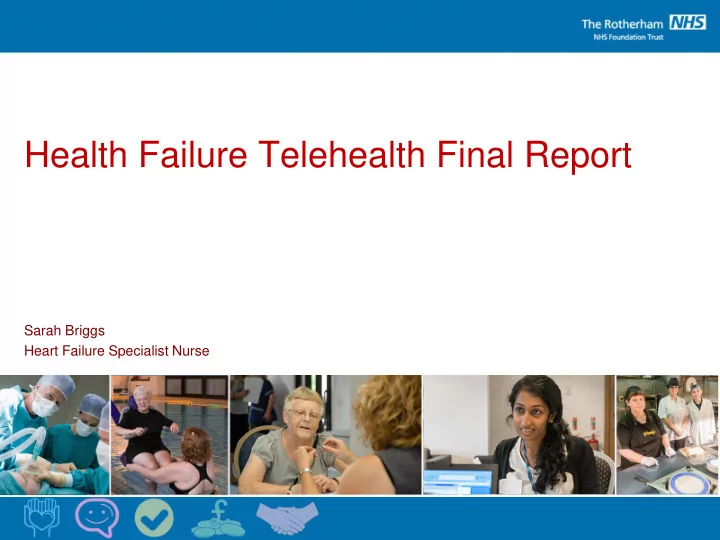

Health Failure Telehealth Final Report Sarah Briggs Heart Failure Specialist Nurse
Heart Failure • Heart failure is a life limiting condition with outcomes worse than most cancers • Heart failure is manifested by severe symptoms and the disease trajectory is unpredictable and punctuated by episodes of decompensation which often results in emergency hospital admission • Heart failure accounts for 5% of all emergency hospital admissions
Heart Failure • Identifying early signs and symptoms of heart failure decompensation, reduces hospitalisation, and improves symptoms and quality of life Cowie et al 2014 Improving care for patients with acute heart failure ESC
Demographics • Population of Rotherham – 258,400 • Population of diagnosed Heart failure – 2,061 = 0.8% of the population • Population of Coronary Artery Disease -11,121 • 75% of heart failure is secondary to coronary artery disease, therefore the incidence of heart failure is projected to increase and could increase by 11,121 in the future • The average age of patients with heart failure is 75years. The rising numbers of older people, particularly in this age group, will result in rising demand for health sevices
• The public and patient awareness of heart failure is extremely poor, often attributing symptoms of breathlessness and/or oedema to old age and so often do not seek advice for symptoms • Hospital admissions could be avoided if patients identified early signs and symptoms of decompensation • The Telehealth project aims to educate and support patients in developing self monitoring behaviour and to enhance confidence and promote patient expertise in the mechanisms associated with acute decompensating heart failure
Telehealth Project • 12 week remote monitoring of weight, BP, HR and responses of questionnaires related to heart failure symptoms • E-programme – 12 week educational programme, weekly topics to increase patient knowledge and expertise – methods include films, quizzes, written material
Project Aims 1. To enable increase in Heart Failure Specialist Nurse Caseloads, specifically most unstable (red) patients. 2. To reduce admissions across Caseloads (additional patients and patients completing programme). 3. To improve outcomes of patients that complete programme, including quality of life. 4. To improve patient confidence in the use of IT (specifically as a means of managing health and wellbeing inc social aspects). 5. To monitor learnings for wider exploitation of digital / remote technologies.
Telehealth Project • 99 patients were registered • 80 patients received telehealth • Average age was 67years old • 20 of the telehealth patients were in their 80s and 90s • Important to have strong links with the CCC and SPS • Support of Consultants and colleagues was vital in service development • The service has now stopped and this evaluation is aimed at supporting decision making going forward
RAG Caseload • RED – Actively/acutely preventing hospital admission - Acutely unstable and complex patient. • Up to twice daily visits • AMBER – Recently unstable, complex needs, at risk of decompensation and hospitalisation. • Visiting as required, usually 1-2 weekly • GREEN – Stable heart failure. Uptitration of medications, and education phase. • Visiting 2-4 weekly or attending community HFSN clinic
Rotherham Deployment Tracker 90 80 Patient 70 Activations 60 Patient Count 50 Devices Delivered 40 30 Live Pts 20 10 0 Date
Patients by gender 60 50 FEMALE 40 30 MALE 20 10 0 1
1. Impact on Referrals TOTAL REFERRALS 450 400 350 300 250 TOTAL REFERRALS 200 150 100 50 0 2012/13 2013/14 2014/15
RED ACCEPTED REFERRALS 80 70 60 50 40 RED 30 20 10 0 2012/13 2013/14 2014/15
2. Impact on Hospitalisation Patients are 3 times more likely to be admitted without Telehealth 50.9% reduction in length of hospital stay
Heart failure Number of admissions Length of stay admissions Telehealth cohort =81 5 5.6 days Rotherham HF 292 (2013) 10 days population 298 (2014) 11 days
3. Impact on Quality of Life Excellence in healthcare • 93% of patients following the Telehealth Engaged, Accountable Colleagues programme now feel confident in their knowledge of heart failure Trusted, open governance • 20% improvement in knowledge of the main symptoms of heart failure Strong financial foundations Securing the future together
3. Impact on Quality of Life Excellence in healthcare • Patients were less frightened to be more active, they more likely to push themselves. • 36% of patients said that their heart condition Engaged, Accountable Colleagues stopped them from doing things what they wanted to do, compared with 61% pre Telehealth. Trusted, open governance • The Telehealth cohort slept better and felt less frustrated and irritable Strong financial foundations • Energy levels were increased by 11% • 5% increase in confidence levels Securing the future together • 27% of patients felt less dependent on others
4. Impact on Confidence in IT • Average age of the Telehealth cohort = 67 • Number of patients in 80s and 90s = 20 • 14% increase in confidence in using IT equipment and decisions to purchase IT equipment following project • 91% of patients now describe themselves as very confident
5. Monitor Wider Learnings Excellence in healthcare • Technology is only one part of service model. Need to consider service staffing / pathways / Engaged, Accountable Colleagues • Managing equipment and installs requires dedicated focus • Patient Drop Outs (prior to experiencing Trusted, open governance equipment) • Telehealth planning needs to be strategic with Strong financial foundations engagement across organisations. Securing the future together
Conclusions • Education and supportive monitoring is the cornerstone for patients to achieve expertise and confidence, which results in improved patient experience and quality of life, reducing hospital admissions and reducing cost burden of Heart failure on the NHS.
Where do we go from here?
Any questions or feedback?
Recommend
More recommend